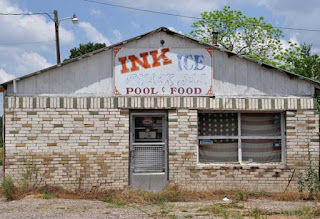The unincorporated community of Ink, Arkansas, located on Highway 88 east of Mena, received its name in 1887. The U. S. Post Office, trying to cut down on duplicated town names, required towns to submit at least three alternate names on the submission form. Instructions on the ballot sheet distributed to the community asking for a town name said, “Write in ink” so that’s what a lot of folks did. When the first choice of “Mellon” was rejected because a different town already had that name, the 2nd most popular choice, “Ink” was awarded. Nobody knows what the 3rd alternate name was.
Even more of a sleepy little town today than it was over 100 years ago, the Ink post office closed its doors in 1967. With only 1 business open (a cement delivery service), and a few widely scattered homes, it is very close to being a full-blown ghost town. It does, however, have a large, very well maintained cemetery which serves the area. The cemetery is home to almost more living things than the community - 2 roadrunners.
 |
| Closed Ink convenience store |
 |
| Ink community center |
 |
| One of the roadrunners living in the cemetery. |
 |
| Abandoned Ink home - the norm |



















